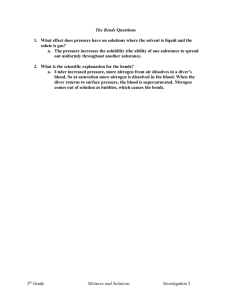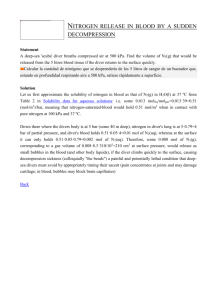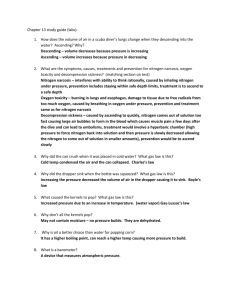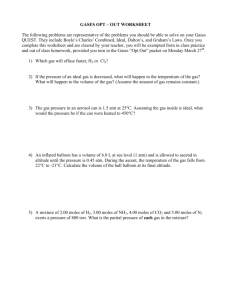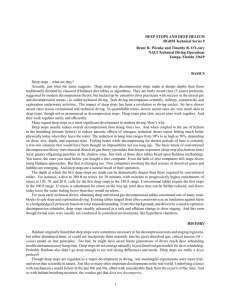ISOBARIC COUNTER GAS TRANSPORT
advertisement
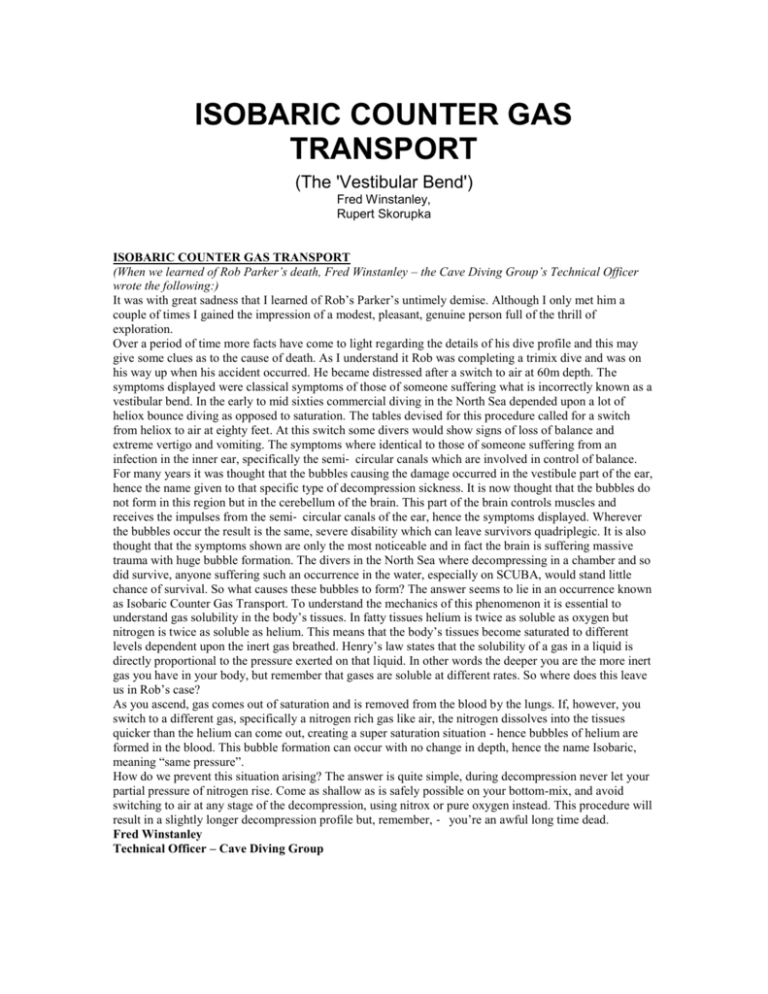
ISOBARIC COUNTER GAS TRANSPORT (The 'Vestibular Bend') Fred Winstanley, Rupert Skorupka ISOBARIC COUNTER GAS TRANSPORT (When we learned of Rob Parker’s death, Fred Winstanley – the Cave Diving Group’s Technical Officer wrote the following:) It was with great sadness that I learned of Rob’s Parker’s untimely demise. Although I only met him a couple of times I gained the impression of a modest, pleasant, genuine person full of the thrill of exploration. Over a period of time more facts have come to light regarding the details of his dive profile and this may give some clues as to the cause of death. As I understand it Rob was completing a trimix dive and was on his way up when his accident occurred. He became distressed after a switch to air at 60m depth. The symptoms displayed were classical symptoms of those of someone suffering what is incorrectly known as a vestibular bend. In the early to mid sixties commercial diving in the North Sea depended upon a lot of heliox bounce diving as opposed to saturation. The tables devised for this procedure called for a switch from heliox to air at eighty feet. At this switch some divers would show signs of loss of balance and extreme vertigo and vomiting. The symptoms where identical to those of someone suffering from an infection in the inner ear, specifically the semi‑ circular canals which are involved in control of balance. For many years it was thought that the bubbles causing the damage occurred in the vestibule part of the ear, hence the name given to that specific type of decompression sickness. It is now thought that the bubbles do not form in this region but in the cerebellum of the brain. This part of the brain controls muscles and receives the impulses from the semi‑ circular canals of the ear, hence the symptoms displayed. Wherever the bubbles occur the result is the same, severe disability which can leave survivors quadriplegic. It is also thought that the symptoms shown are only the most noticeable and in fact the brain is suffering massive trauma with huge bubble formation. The divers in the North Sea where decompressing in a chamber and so did survive, anyone suffering such an occurrence in the water, especially on SCUBA, would stand little chance of survival. So what causes these bubbles to form? The answer seems to lie in an occurrence known as Isobaric Counter Gas Transport. To understand the mechanics of this phenomenon it is essential to understand gas solubility in the body’s tissues. In fatty tissues helium is twice as soluble as oxygen but nitrogen is twice as soluble as helium. This means that the body’s tissues become saturated to different levels dependent upon the inert gas breathed. Henry’s law states that the solubility of a gas in a liquid is directly proportional to the pressure exerted on that liquid. In other words the deeper you are the more inert gas you have in your body, but remember that gases are soluble at different rates. So where does this leave us in Rob’s case? As you ascend, gas comes out of saturation and is removed from the blood by the lungs. If, however, you switch to a different gas, specifically a nitrogen rich gas like air, the nitrogen dissolves into the tissues quicker than the helium can come out, creating a super saturation situation - hence bubbles of helium are formed in the blood. This bubble formation can occur with no change in depth, hence the name Isobaric, meaning “same pressure”. How do we prevent this situation arising? The answer is quite simple, during decompression never let your partial pressure of nitrogen rise. Come as shallow as is safely possible on your bottom-mix, and avoid switching to air at any stage of the decompression, using nitrox or pure oxygen instead. This procedure will result in a slightly longer decompression profile but, remember, ‑ you’re an awful long time dead. Fred Winstanley Technical Officer – Cave Diving Group (In reply, Rupert Skorupka, a Qualified Diver with the Cave Diving Group (Northern Section) wrote:) Fred Winstanley’s article (copied above) on the subject of Isobaric Counter Gas Transport, whilst being generally correct and informative, was rather brief to deal with such a complex subject. I have therefore attempted to produce a more in depth explanation of the principles involved in this phenomenon. (Those divers not interested in the details of diving physiology should move on to prevent an attack of acute boredom.) My main contention with Fred’s article is that we are discussing a phenomenon governed by the principles of diffusion rather than solubility, and that the biological site at which this occurs is the cell membrane, rather than fatty tissues in general. Let us specifically follow the course of events after a gas switch from a high percentage helium mix to a high percentage nitrogen mix during ascent (partial pressures being irrelevant as we are observing at isobaric conditions), from the point of view of an interneuron (i.e. nerve cell), from which a large proportion of the cerebellum is composed. A high concentration of nitrogen is carried in solution, by bulk flow in the bloodstream. Rapid diffusion occurs via the aqueous medium into the extra cellular fluid surrounding the interneuron. A situation then exists whereby two aqueous compartments are separated by the cell membrane, one containing a high nitrogen concentration (extracellular), and one containing a high helium concentration (intracellular). The mechanism by which equilibrium is reached is by passive diffusion through the membrane. (i.e. generated only by the concentration gradient) until the concentrations in both compartments equalise. The rate at which any molecule can pass through the cell membrane is given by its permeability constant. This will depend on factors such as the size of the molecule, its diffusion coefficient and its partition coefficient between the lipid and aqueous phases of the cell. So even though the helium atom moves three times as fast as the nitrogen molecule in terms of its diffusion rate, the nitrogen molecule can cross the cell membrane more rapidly as it has a higher permeability constant. The flux of molecules across the cell membrane therefore results in more nitrogen molecules entering the cell cytoplasm than helium atoms leaving. Since the partial pressure of any component in a mixture of gases above a solution is directly proportional to the number of molecules of that gas dissolved in the solution, it follows that as the number of molecules of nitrogen in the cytoplasm increases, then the partial pressure required to prevent them coming out of solution also increases. Consider the simplified situation of a diver decompressing at 20 metres i.e. 3atms. Supposing he arrived at the stop with tissue partial pressures of 2.5atm helium, 0.5atm nitrogen. 10 minutes after switching to air, these have changed due to isobaric counter diffusion, to 2.3atm helium, 1.0atrn nitrogen. Thus he is still not supersaturated for either gas (i.e. neither exceeds 3atm). But, the crucial principle is that these partial pressures are additive with respect to the tendency to form a gas phase. Thus bubble formation will now occur, whether for helium, nitrogen or a mixture (a difficult question). The site of bubble formation will be the cellular cytoplasm, not the bloodstream as Fred states. This simply means that damage to our interneuron is not indirectly caused by it being starved of oxygen and nutrients due to bubble occlusion of the capillaries but by physical disruption of the cellular mechanisms from within. If the damage was to effect the cerebellum alone, the diver would display very distinctive symptoms of DCS. The cerebellum does not initiate movement, but acts by influencing other regions of the brain responsible for motor activity. Destruction of the cerebellum does not cause the loss of any specific movement, rather it is associated with general inadequacy of that movement. Damage to the cerebellum would cause our diver symptoms as follows: 1 . He cannot perform movements smoothly. These are accompanied by oscillating tremors. 2. His walk is awkward and drunken, with difficulty maintaining balance. 3. He cannot start or stop movements quickly or easily. 4. He may not be able to combine the movement of several Joints into a smoothly co-ordinated motion. The most important factor from the point of view of the cave diver decompressing in water is the rapid time scale over which these events occur. The symptoms are likely to be so severe that they result in death by drowning within minutes of the gas switch having taken place. Now to the question of how we prevent the situation arising in the first place. Obviously, using trimix will have an advantage over heliox as the cells will have an inherent partial pressure of nitrogen, thereby decreasing the concentration gradient over the cell membrane after the gas switch. Fred advocates never allowing the partial pressure of nitrogen to rise during the decompression. If breathing heliox, this would entail carrying out all decompression on pure oxygen, no nitrogen would be permitted whatsoever. Consider the case of a diver using a 50% helium trimix (i.e. 40% nitrogen 10% oxygen). In order to maintain an equal nitrogen partial pressure during decompression he would have to switch to a 60% oxygen nitrox. In order to avoid acute oxygen toxicity for any significant period of decompression, it is necessary to keep the PP02 below 1.6atm. Thus for an f02 of 0.6, it would be inadvisable to switch to this mix below 17 metres. Our diver therefore would not be able to switch from his bottom mix until this depth was reached, resulting in a massive (if not unsustainable) time increase to the deeper stops. The present consensus of opinion recommends a switch to nitrox at or around 30 metres. This depth lies at an optimal point where the f02 that can be safely tolerated is sufficiently high to reduce the fN2 in our mix to a level that more closely approximates to the fN2 in our trimix (i.e. an fN2 of 0.4 as opposed to approximately 0.8 for air). Also, by maximising the f02, we take advantage of the phenomenon known as the oxygen window. Simply put, this is the mechanism whereby oxygen dissolved in the blood is absorbed and metabolised by our cells in preference to that combined with haemoglobin, which does not contribute to the PP02. At high partial pressures this is the predominant fraction of the inspired oxygen. As this oxygen is metabolised, it leaves a partial pressure “window” in the tissues, which enables the other inert gases to increase their partial pressures without bubble formation. Reading accounts of past deep diving exploits it becomes apparent that some frightening practices were used during decompression, seemingly accepting vestibular bends as a necessary occupational hazard. The problem was, predictably, evaluated by Jochen Hasenmayer during his Fontaine de Vaucluse dives. Unfortunately, the details of his decompression procedures were kept a secret. It is probable that the vestibular bend strikes with the same random pattern of distribution as DCS in general, being more common in extreme exposures but by no means limited to these cases, and not an inevitable consequence of deep gas switches. What is probable is that in the past due to an overall ignorance of the facts concerning isobaric gas diffusion, and even its existence at all, several deaths have been wrongly attributed to other factors such as severe nitrogen narcosis during decompression. For example refer to the American publication “Mixed Gas Diving” by Mount and Gilliam. I could not find one reference to vestibular bends or isobaric counter diffusion in the entire book. Hopefully, we can continue to avoid accidents in the future by learning from the mistakes of our predecessors. We owe it to them to improve our techniques and thereby prevent the pointless repetition of past tragedies. Rupert Skorupka Cave Diving Group
